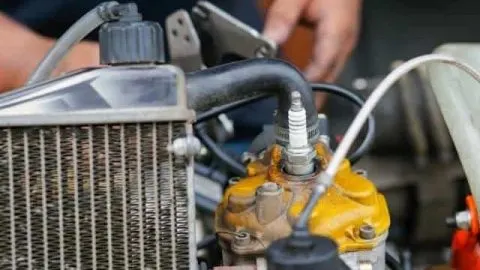A flooded engine can be annoying, stopping you in your tracks before you even manage to get anything done. Fortunately, diagnosing and fixing flooding problems with a two-stroke engine is quite simple. In fact, in many cases, it requires nothing on your part at all.
While most cases of engine flooding have a simple fix, there are a few scenarios that can make diagnosing and fixing the problem more complex. Keep reading this article to learn how to quickly and easily diagnose engine flooding, find the root of the problem, and fix the common causes.
Diagnosing and Fixing Two-Stroke Flooding Problems
Two-stroke engines, also known as two-cycle engines, are engines that can complete a cycle with two up and down movements, called strokes. While the details of a two-stroke engine’s inner workings are not important for dealing with flooding, it holds some relevance to what can cause flooding and why it is so easy to fix.
In fact, because two-stroke engines are so simple, they have fewer moving parts, making diagnosis and maintenance easier than other popular engine types, such as a four-stroke engine. For instance, it is entirely possible to recognize and solve two-stroke engine flooding with a simple sniff and some time.
Diagnosing Flooding Problems
When it comes to a two-stroke engine, flooding is a common problem, but it is not a difficult one to diagnose. After all, flooding is simply a case of too much fuel in the combustion chamber, which causes it to be unable to ignite and thus impossible to start.
To find out whether your problem is flooding and not something else, a good place to start is a sniff test. Being as simple as it sounds, a sniff test involves sniffing the air for the smell of gas. The steps of a sniff test are:
- Attempt to start the engine
- If the engine begins to sputter but does not start, sniff the air
- If you smell gasoline, then you are likely dealing with a flooded engine
If you cannot get the engine to sputter, the easiest way to diagnose flooding is to check the spark plug. If the spark plug is coated in gas, the engine is flooded. Removing the spark plug and drying it thoroughly is recommended (source).
Otherwise, it might be necessary to delve deeper and see whether that is really the problem.
The Causes of a Flooded Two-Stroke Engine
Flooding is a simple problem to diagnose, but it is not always simple to fix. Understanding what can cause a flooded engine is important for knowing where to look and what you need to do to solve the problem, especially if the problem is not something simple, such as user error.
Common causes of a flooded engine include:
- Over-priming
- Closed choke
- Dirty air filter
- Blocked carburetor
User error is actually the most common cause of a flooded engine. Two examples of user error are over-priming and a closed choke.
Over-priming is adding too much fuel to the combustion chamber, which occurs with too many failed attempts at starting an engine, whether due to faulty equipment or not knowing the proper way to start it. As for a closed choke, it is as simple as the turn of a dial or the flip of a switch. Simply ensure it is in the correct position.
As for a dirty air filter or blocked carburetor, they can be more difficult. While not too difficult to access, these two parts require more doing, often needing to be thoroughly cleaned or replaced. Consult an owner’s manual or online resource for directions on how to access them in your specific machine if you think they are problematic.
This YouTube video gives an excellent explanation of the flooding causes in a two-stroke engine:
Fixing a Flooded Two-Stroke Engine
Fixing a flooded two-stroke engine and making sure the fix sticks are largely dependent on the cause. If user error is the cause, then the solution is simple. In fact, if you are not in a rush to use the piece of equipment, simply letting it sit will allow the engine time to dry and allow it to be started.
While the conventional method is time, that does not mean it is the only method. If you are in a rush to start the engine, you can take some additional steps to try and get the engine started more quickly.
To quickly fix a flooded two-stroke:
- Remove the spark plug
- Deactivate the choke if there is one and attempt to start the engine until the combustion chamber is clear
- Wipe excess fuel from the spark plug, reinsert it, and start the engine
Removing the spark plug is fairly simple but you will need the right size socket for your plug. This five-piece spark plug socket set (link to Amazon) covers the most common sizes.
Attempting to start the engine repeatedly (without choking) will help to flush the excess fuel from the carburetor (source).
It is important to consider the piece of equipment you are working with. For instance, if the engine is part of a smaller piece of equipment, like a weed eater or chainsaw, place it on a flat surface to prevent excessive movement while working on it.
More Complicated Solutions to More Complicated Problems
The truth is, two-stroke engines are not difficult to work with. Even the more complicated problems are not difficult to detect and fix. However, if the problem lies with an air filter or a carburetor, you will need to take some additional steps.
For an air filter, the basic steps involve removing a few screws and carefully replacing the air filter inside, only requiring a few simple steps. The location and needed tool will depend on the piece of equipment and model, but it should not be much more complicated than finding the right spot and doing a quick replacement.
On the other hand, cleaning a carburetor is far more complex, not impossible, but certainly tedious. It requires the disassembly of a small piece with many parts before cleaning and reassembling it. If you believe your flooding problem has to do with your carburetor, you can find in-depth tutorials online. However, the basic steps are:
- Disassemble the carburetor
- Clean the carburetor using carburetor cleaner
- Carefully clean the other parts previously removed
- Dry the parts and reassemble
Tools You Might Need
Chances are, you will not need many tools when diagnosing and fixing a flooded engine. In fact, if the problem only requires time, you will not need anything. However, if you wish to take the more expedient option, you will need a spark plug wrench, and having a cloth or towel you do not mind getting dirty is also a good idea.
If fixing your flooding problem requires a new air filter or the cleaning of a carburetor, then you may need other tools as well, such as:
- The appropriately sized screwdriver
- The proper type of air filter
- Carburetor cleaner
- Compressed air
While the specific needs will depend on what the engine is powering, from weed eater to dirt bike, the basics are the same. And, if all else fails, give it more time or contact a professional.
Conclusion
Engine flooding in a two-stroke engine is a common problem, one that occurs especially often with amateurs. Fortunately, it can be diagnosed and fixed easily and quickly, normally only requiring time and patience to clear up on its own. Therefore, if you are experiencing engine flooding, do not fret, as a simple solution is only a few steps away.

